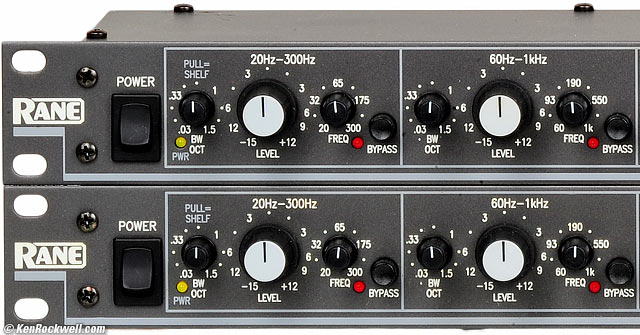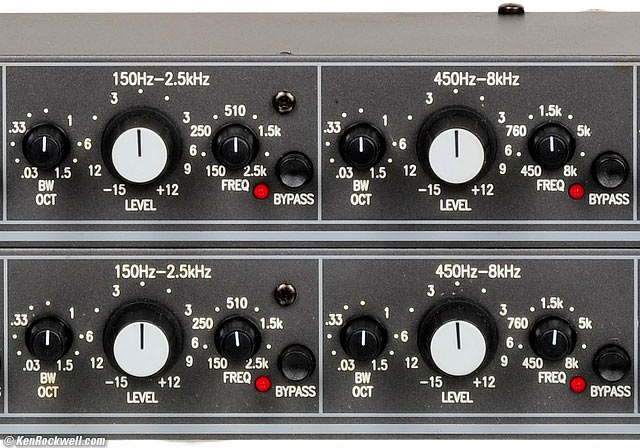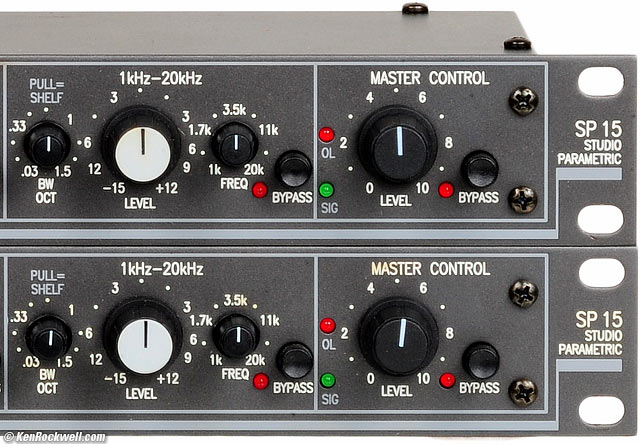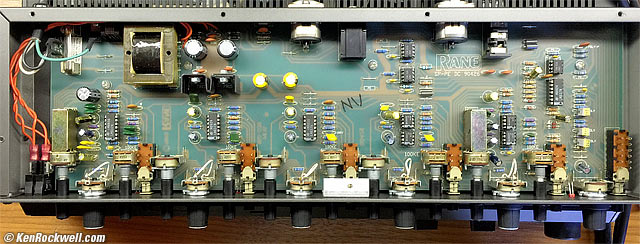Home Donate New Search Gallery Reviews How-To Books Links Workshops About Contact
Rane SP-15
Parametric Equalizer (1985-1994)
Made in USA
© 2015 KenRockwell.com. All rights reserved.
Intro Specs Sound Measurements Usage Recommendations More
Two Rane SP 15 (1 RU, 5-band parametric, 6W idle power draw, about $100 each, used). I've bought four at this link directly to them at eBay (see How to Win at eBay). enlarge.
Rear, Rane SP 15. enlarge.
This all-content, junk-free website's biggest source of support is when you use those or any of these links to approved sources when you get anything, regardless of the country in which you live. Buy only from the approved sources I use myself for the best prices, service, return policies and selection. Thanks for helping me help you! Ken.
April 2015 Rane Reviews Audio Reviews All Reviews
Left side, two Rane SP 15s. enlarge.
Middle, two Rane SP 15s. enlarge.
Right side, two Rane SP 15s. enlarge.
Introduction top
Intro Specs Sound Measurements Usage Recommendations More
The Rane SP 15 is an unusually flexible 5-band parametric equalizer. It's a single-channel, 1 RU device. I show and measure two of them for stereo.
It has five bands that cover ideal ranges, the top and bottom bands also work as shelving controls, and every knob is both very legible and very easy to adjust both quickly and precisely.
The band gain pots all have perfect center detents, and each band also has an individual bypass button.
There is also a hard-wired overall bypass switch, meaning signal comes through even with the power off.
Bands
Band Centers
20 to 300 Hz
60 to 1,000 Hz
150 Hz to 2.5 kHz
450 Hz to 8 kHz
1 to 20 kHz
Band widths
1/30 to 1.5 octaves
Boost/cut
+12/-15 dB
History
The first version, tested here, was made 1985 ~ 1990. It uses ±15V power rails. It has a single operational amplifier IC for its balanced input, and derives its inverting output from a second inverting operational amplifier IC.
The newer version, made from 1991-1994, uses ±18V rails, uses a more complex two-operational amplifier IC balanced input, and uses a clever active balanced output stage which is much happier if one side is connected to ground for use as an unbalanced output, but it has no SIGNAL LED.
In 1995 the SP-17 and PE-17 replaced these. Each of the 5 bands now has a switch to let it cover anywhere from 10 to 20,000 Hz and it also adds variable hi- and lo-pass filters. but the shelving modes of the top and bottom bands is gone.
Circuit Description
The input is an operational amplifier IC or two with precision 0.1% 1 kΩ resistors for about 60 dB CMRR.
The output of the balanced input operational amplifier IC(s) is fed to an operational amplifier IC that detects and lights the SIGNAL LED at about 100 mV RMS input, and then passes the signal through the MASTER LEVEL CONTROL to a 12 Hz, 18 dB/octave high pass operational amplifier IC filter. The MASTER LEVEL CONTROL's position on the right side of the front panel is misleading because it's actually an input level control.
The high-pass filter operational amplifier IC feeds the internal equalizer circuitry.
The operational amplifier IC that drives the OVERLOAD LED detects level at both input and output of the internal equalizer section, not at the actual input or output of the SP-15.
The output of the equalizer section is fed to two operational amplifier ICs (one inverting) that create the balanced output. The newer version uses a smarter actively-balanced output driver. Each output amplifier feeds the SP-15's output connector through a 100 Ω resistor.
The ICs are socketed, making it trivial to update them. The unit tested here had four LM837N, four LM833N and three SSM2134 in it, which is different than listed on the schematic. I don't know if it had been updated, or if Rane simply used different parts. At least three of mine use these same ICs.
Good
Made in USA.
Very flexible.
Easy to adjust and read from arm's length. Even the tiny rotary pots are easy to adjust precisely as the larger knobs.
Overall hard-wire bypass, with warning LED.
Bypass switch for each band, each with warning LED.
Top and/or bottom bands easily converted to shelving, with wide-range selection of turnover frequency. (Pull Q knob for SHELF; Q setting ignored in SHELF.)
OVERLOAD and SIGNAL LEDs.
Active balanced inputs and outputs easily used as unbalanced with ¼" to RCA adapters.
EQ is completely flat at the detented zeros.
Always-active 12 Hz, 18 dB/octave low-cut filter right after active balanced input operational amplifier IC.
Always-active 70 kHz, 12 dB/octave LC RFI filter at input.
Turns on immediately and turns off in about a second, with only minimal thumps and no muting relay.
Low power consumption: 6 watts actual measured per channel.
Bad
2 kΩ input impedance may load wimpy consumer equipment, especially if used with unbalanced Hi-Fi gear.
No LEDs for SHELF mode.
Innards, Rane SP 15. enlarge.
Specifications top
Intro Specs Sound Measurements Usage Recommendations More
See the Rane SP-15 manual:
2 kΩ input impedance.
+23 dBu maximum input.
+28 dBu into 600 Ω maximum output.
Active balanced inputs and outputs.
Overall gain: off to +12 dB.
Power: 120 VAC only.
Fuse: 100 mA.
Size: 5.25" deep, 1 RU (19 x 1.75").
Weight: 5 pounds.
Quality: MADE IN USA.
Measurements top
Intro Specs Sound Measurements Usage Recommendations More
These measurements are made with an exotic Rohde & Schwarz UPL laboratory analyzer. The traces from the Rohde & Schwarz UPL laboratory analyzer are color coded for the Left Channel 1 and for the Right Channel 2. When they don't lie on top of each other, it's due to channel imbalance. When they do lie on top of each other, the trace turns blue.
Unless otherwise specified, all measurements are RMS at 1 kHz at 1 V into 200 kΩ, unbalanced RCA inputs and outputs.
SIGNAL LED
The SIGNAL LED lights at about 100 mV input, regardless of any other settings.
GAIN
Balanced
Unity gain is at about 7.
Measured with 200 kΩ load and 10 Ω source.
Balanced |
Left |
Right |
MAX |
+18.081 dB |
+18.004 dB |
9 |
+14.0 dB |
+14.4 dB |
8 |
+6.5 dB |
+6.2 dB |
7 |
+1.4 dB |
+0.1 dB |
6 |
-1.0 dB |
-2.4 dB |
5 |
-2.5 dB |
-3.6 dB |
4 |
-4.6 dB |
-5.8 dB |
3 |
-6.8 dB |
-9.4 dB |
2 |
-15.2 dB |
-15.1 dB |
1 |
-21.6 dB |
-27.0 dB |
Unbalanced
Unity gain is at about 8.
Unbalanced |
Left |
Right |
MAX |
+12.056 dB |
+12.083 dB |
9 |
+8.3 dB |
+6.8dB |
8 |
+0.3 dB |
+0.3 dB |
7 |
-5.6 dB |
-4.7 dB |
6 |
-8.4 dB |
-7.3 dB |
5 |
-9.5 dB |
-8.7 dB |
4 |
-11.7 dB |
-10.6 dB |
3 |
-14.0 dB |
-14.0 dB |
2 |
-21.7 dB |
-21.7 dB |
1 |
-32.6 dB |
-32.6 dB |
MOL
Balanced
15.535 V at OVER at 0.07% THD at 200 kΩ.
11.614 V at OVER at 0.07% THD at 600 Ω.
9.263 V at OVER at 0.95% THD at 300 Ω.
Unbalanced
6.7 V at OVER at 0.06% into 200 kΩ.
It's the same if driven from the AD-1702's high outputs.
Output Source Impedance
200 Ω, measured at 1 kHz, balanced.
100 Ω, measured at 1 kHz, unbalanced.
Output Noise
Measured at unity gain. "MASTER" level control is at the input, so the noise levels vary little with this control.
Noise goes up as GAIN controls are moved away from zero, whether of not they are set to boost or cut, and whether or not they are set to BYPASS.
Balanced
A-weighted: -94 dBV, gain controls at zeros; -80.5 dBV, gain controls at minimums.
Unweighted, 22 kc bandwidth: -91 dBV, gain controls at zeros; -75.4 dBV, gain controls at minimums.
Unbalanced
A-weighted: -90.6 dBV gain controls at zeros; -73.5 dBV, gain controls at minimums.
Frequency Response — Set Flat
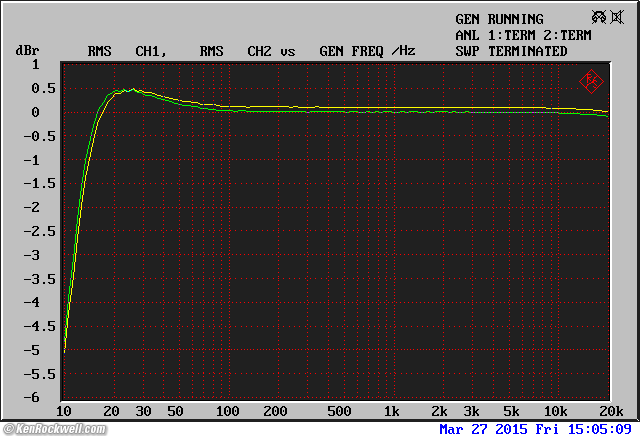
Rane SP 15 Frequency Response.
This is the response of the low-pass filter. It cuts subsonics and leaves the music alone. It's ±0.5 dB to 14.5 Hz and down 22 dB at 5 Hz.
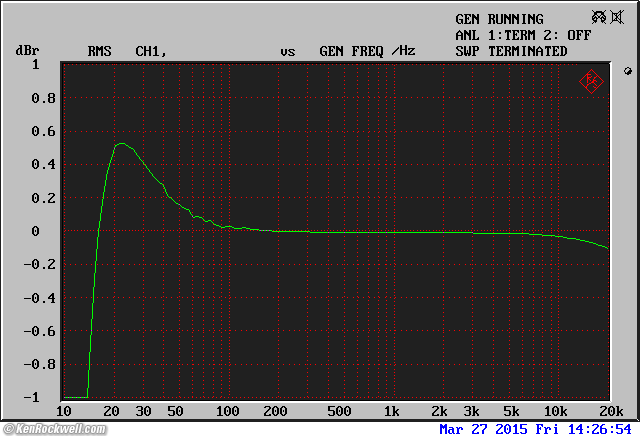
Rane SP 15 Frequency Response, expanded scale.
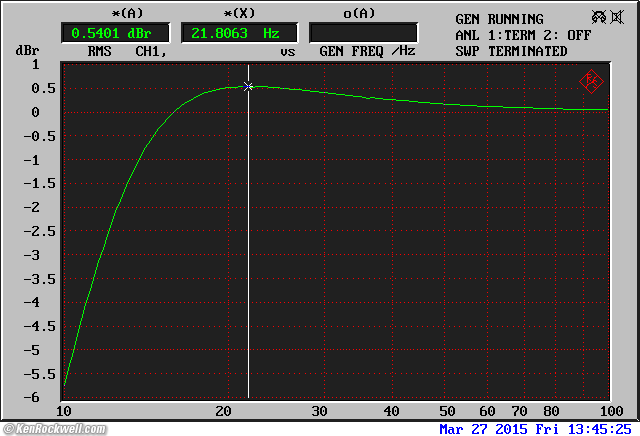
Rane SP 15 Frequency Response, 10-100 Hz.
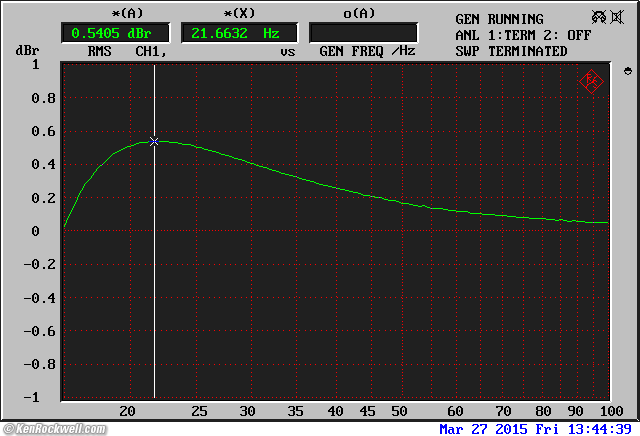
Rane SP 15 Frequency Response, 16-100 Hz.
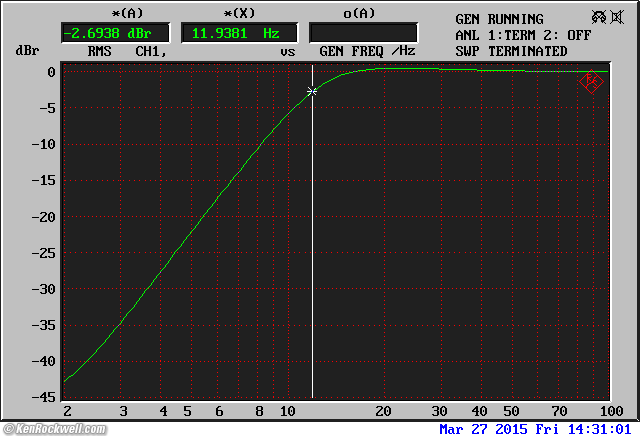
Rane SP 15 Frequency Response, 2-100 Hz.
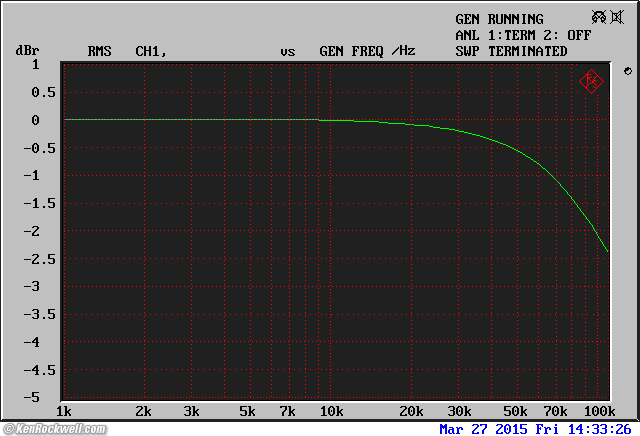
Rane SP 15 Frequency Response, 1-110 kHz.
it's ±0.5 dB 14.5 Hz to 47 kHz, which is perfect.
Frequency Response — Equalizing
Lowest Band, Peak
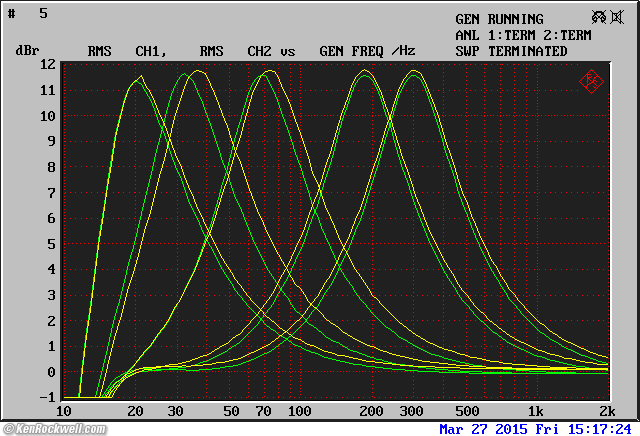
Rane SP 15 Frequency Response, lowest band at +12 dB, Q at 12 o'clock, set to 20, 32, 65, 175 and 300 Hz.
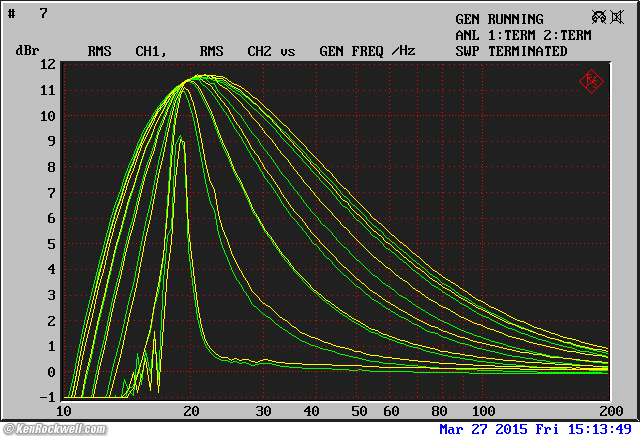
Rane SP 15 Frequency Response, 20 Hz peak at +12 dB, Q varied 7 points.
Lowest Band, Shelf
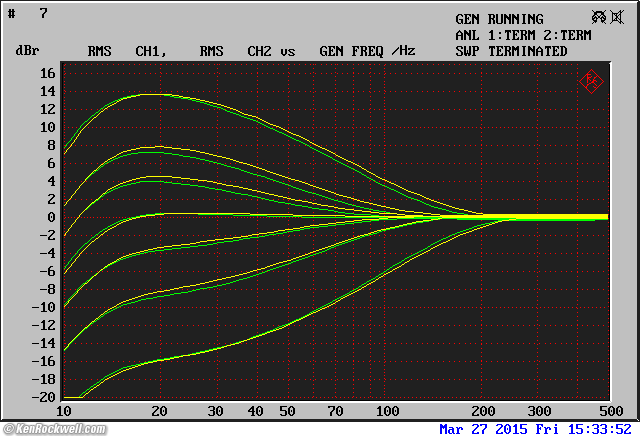
Rane SP 15 Frequency Response, Low Shelf at 65 Hz, gain varied 7 points.
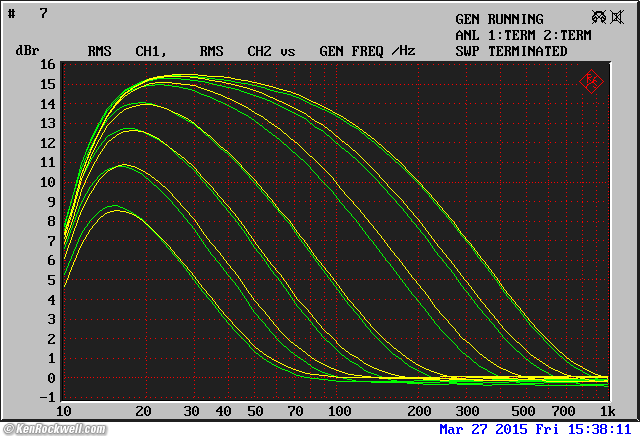
Rane SP 15 Frequency Response, Low Shelf at +12 dB at 7 frequencies.
Middle Band, Peak
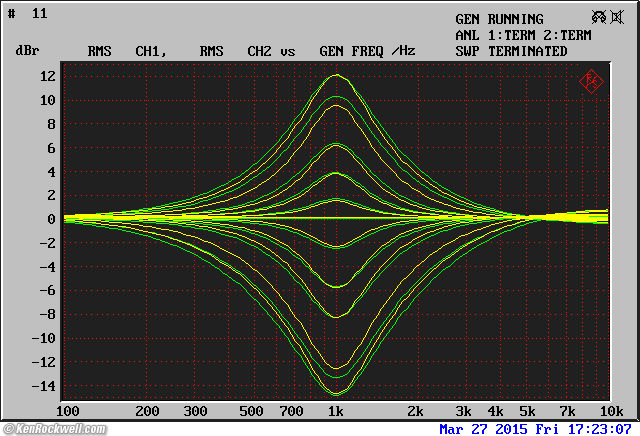
Rane SP 15 Frequency Response, Middle Band at 1 kHz, Q at 12 o'clock, Gain at each marking (-15, -12, -6, •, -3, 0, •, +3, +6, +9 and +12).
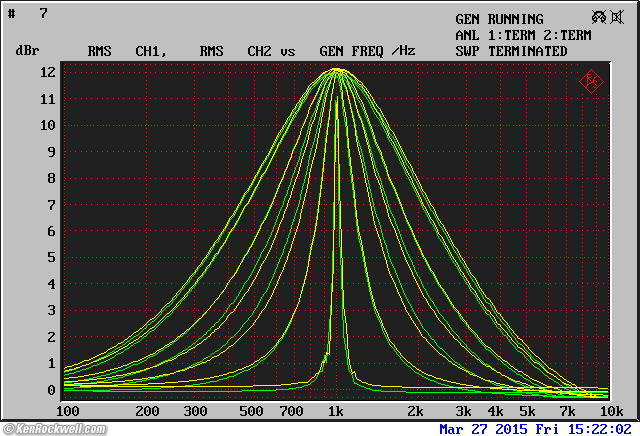
Rane SP 15 Frequency Response, Middle Band at 1 kHz at +12 dB at 7 Qs.
Highest Band, Shelving
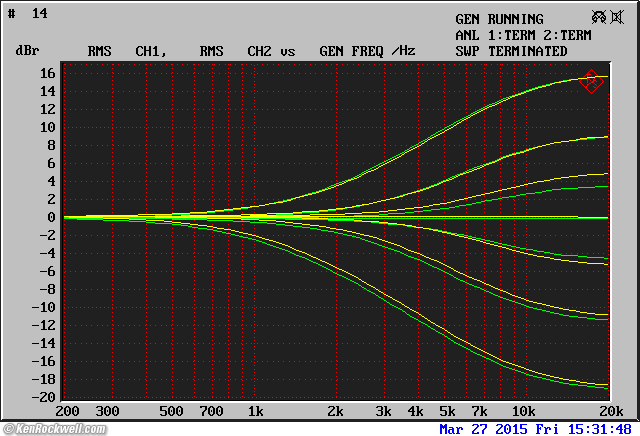
Rane SP 15 Frequency Response, High Shelf at 3.5 kHz at 7 levels.
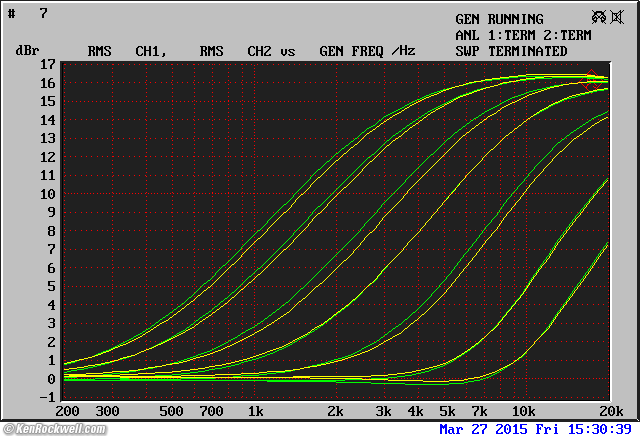
Rane SP 15 Frequency Response, High Shelf at +12 dB at 7 frequencies.
Distortion
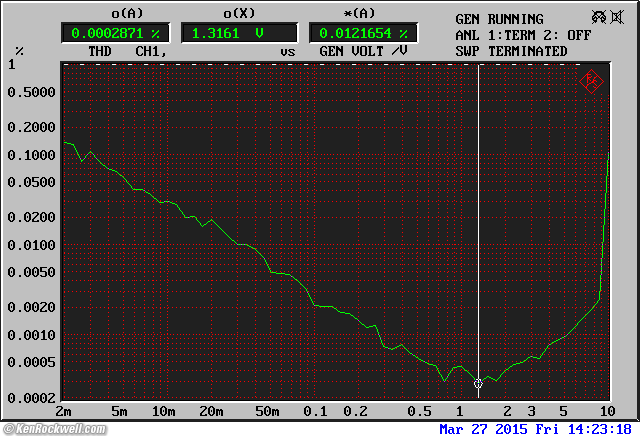
Rane SP 15 THD at 1 kHz.
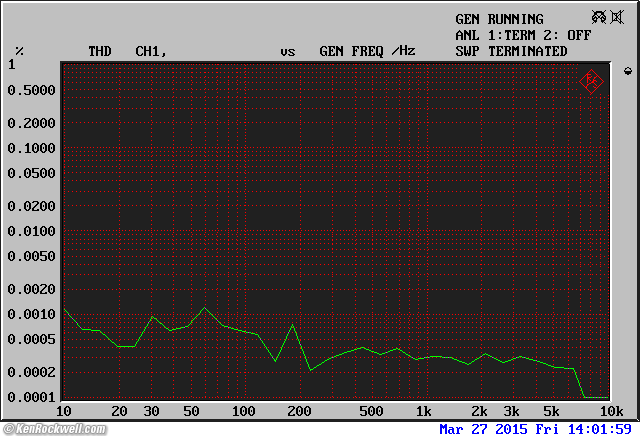
Rane SP 15 THD at 1 Volt.
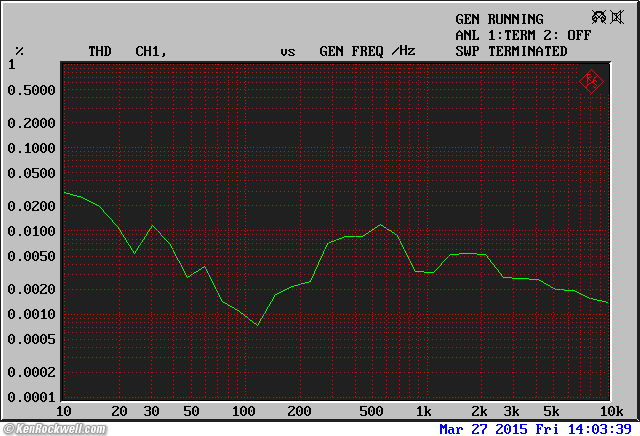
Rane SP 15 THD at 1 Volt, filter band gains alternately set to +12 or -15 dB, F and Q set at 12 o'clock.
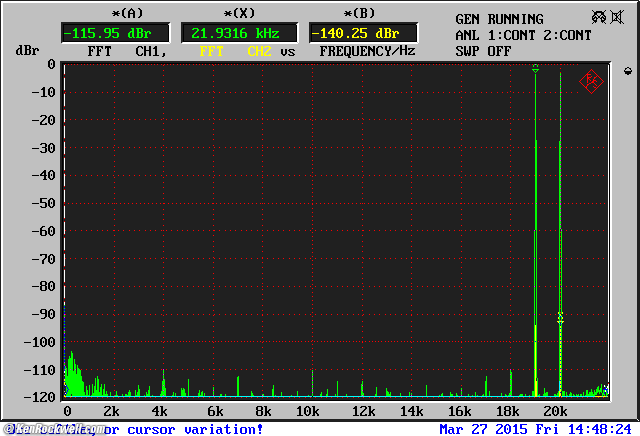
Rane SP 15 19+20 kHz DFD at 1 Volt.
6 watts.
Oddly it draws 1 watt turned off, which is because the power switch is in the secondary of the power transformer. This way the switch only switches low voltage and 120 VAC isn't running all over the insides of the case, but it does mean the transformer is always energized.
I've bought four from random strangers over eBay. All four have clean pots, which is marvelous, but some of the bypass switches arrive a little dirty.
They cleaned up themselves with use, otherwise the output levels can seem off if the MASTER BYPASS switch is dirty, and any of the bands may have no effect if you need to jiggle its bypass switch.
No big deal, if yours arrives with any flaky switches, pushing them several times usually clears the corrosion, and they get better with use.
Usage top
Intro Specs Sound Measurements Usage Recommendations More
Use some ¼" to RCA adapters and it will work with better Hi-Fi gear.
The early version works fine with these, but do know that the inverting output driver is shorted to ground via a 100 Ω output resistor. With the first version for unbalanced output, it is more elegant to use only the hot side and leave the low side disconnected.
For unbalanced HiFi use, you could bypass the input operational amplifier IC and connect the input instead to the top of the LEVEL control.
Pull the Q knob for SHELF. The Q setting is ignored in SHELF, but the frequency adjusment is active.
Recommendations top
Intro Specs Sound Measurements Usage Recommendations More
These are inexpensive and versatile equalizers. They're easy to use, and with their shelving controls also work as simple tone controls.
If you find my work here helpful, this all-content, junk-free website's biggest source of support is when you use this link directly to them at eBay (see How to Win at eBay) or any of these links to approved sources when you get anything, regardless of the country in which you live. Buy only from the approved sources I use myself for the best prices, service, return policies and selection.
Thanks for helping me help you!
Ken.
More Information top
Intro Specs Sound Measurements Usage Recommendations More
Rane's SP 15 schematic, 1987-1990 version tested here
Rane's SP 15 schematic, newer 1991-on version
Help me help you top
I support my growing family through this website, as crazy as it might seem.
The biggest help is when you use any of these links to approved sources when you get anything, regardless of the country in which you live. It costs you nothing, and is this site's, and thus my family's, biggest source of support. These places have the best prices and service, which is why I've used them since before this website existed. I recommend them all personally.
If you find this page as helpful as a book you might have had to buy or a workshop you may have had to take, feel free to help me continue helping everyone.
If you've gotten your gear through one of my links or helped otherwise, you're family. It's great people like you who allow me to keep adding to this site full-time. Thanks!
If you haven't helped yet, please do, and consider helping me with a gift of $5.00.
As this page is copyrighted and formally registered, it is unlawful to make copies, especially in the form of printouts for personal use. If you wish to make a printout for personal use, you are granted one-time permission only if you PayPal me $5.00 per printout or part thereof. Thank you!
Thanks for reading!
Mr. & Mrs. Ken Rockwell, Ryan and Katie.
Home Donate New Search Gallery Reviews How-To Books Links Workshops About Contact


